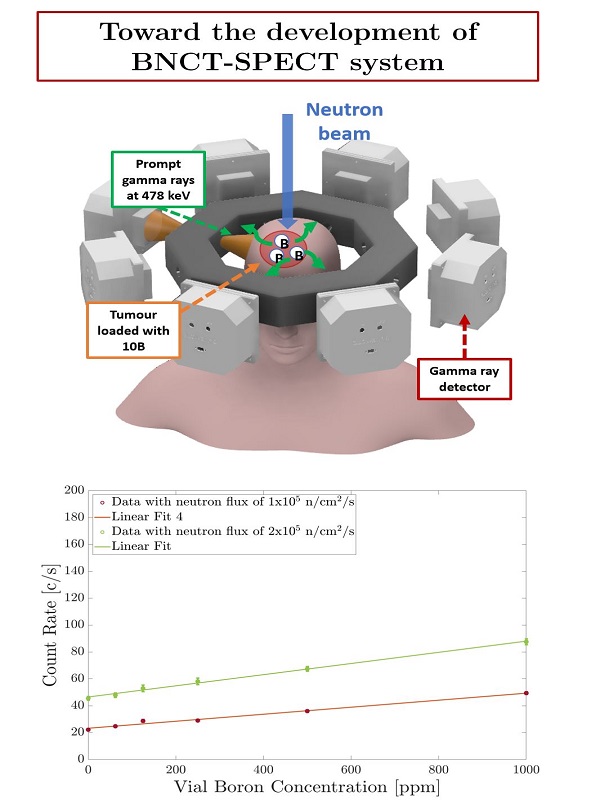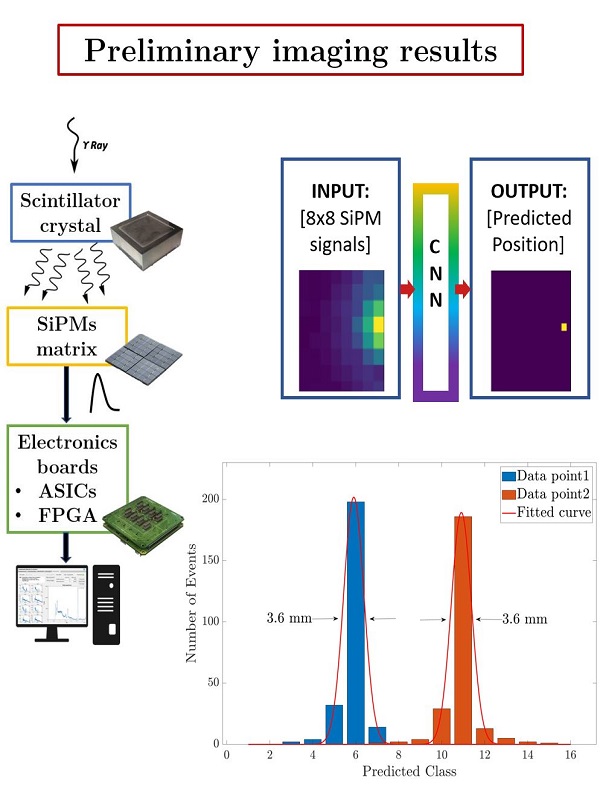Development of a gamma-ray detector for dose monitoring in BNCT
OC-0772
Abstract
Development of a gamma-ray detector for dose monitoring in BNCT
Authors: Anita Caracciolo1, Davide Di Vita1, Tommaso Ferri2, Marco Carminati2, Nicoletta Protti3, Saverio Altieri4, Franco Camera5, Carlo Fiorini2
1Politecnico di Milano , Dipartimento di Elettronica, Informazione e Bioingegneria, Milan, Italy; 2Politecnico di Milano, Dipartimento di Elettronica, Informazione e Bioingegneria, Milan, Italy; 3Università di Pavia, Dipartimento di Fisica, Pavia, Italy; 4Università di Pavia, Dipartimento di Fisica , Pavia, Italy; 5Università degli Studi di Milano Statale, Dipartimento di Fisica, Milan, Italy
Show Affiliations
Hide Affiliations
Purpose or Objective
We report the experimental validation of a gamma ray detection prototype as a basic element for a SPECT system for dose monitoring in Boron Neutron Capture Therapy (BNCT). BNCT is a targeted radiotherapy technique where tumor cells are loaded with 10B-enriched molecules and then irradiated with thermal neutrons. Reactions following neutron capture by 10B produce damage limited to the diameter of the single tumoral cell. A fundamental issue to fully exploit this excellent targeting capability is the in-vivo and real time measurements of 10B captures. This can be achieved by detecting the 478 keV prompt gamma rays that are emitted in 94% of the 10B(n,α)7Li reactions. The intensity of the 478 keV gamma rays is proportional to the boron local dose, thus a SPECT system can be used to monitor the 3D treatment effect in real time. However, the detection of these gamma rays is very challenging because of the high intensity neutron sources required in BNCT, that leads to a sever background of neutrons and secondary gamma rays.
We propose the development of a SPECT apparatus consisting of multiple LaBr3 scintillator crystal detectors. We report the results achieved with a first prototype detector.
Material and Methods
The proposed detection module is based on a 2 inches cylindrical LaBr3(Ce+Sr) scintillator crystal, coupled with a matrix of 8x8 Silicon Photomultipliers (SiPMs), read by 4 custom ASICs. To validate the spectroscopic capabilities of the detector in a BNCT scenario, we have performed measurements inside the Prompt Gamma Neutron Activation Analysis (PGNNA) facility of TRIGA Mark II (Pavia, Italy). Vials filled with increasing concentration of 10B, down to 62 ppm, have been irradiated with thermal neutron fluxes of the order of 105 n/cm^2/s.
To verify the imaging capabilities of the detector we have used a square crystal with a small thickness of 20 mm instead of the cylindrical one. The crystal surface has been scanned with a 1 mm 137Cs collimated source (662 keV). The SiPMs signals patterns have been used to train a Convolutional Neural Network (CNN). A dedicated collimator has been designed and it is currently under construction.
Results
The good energy resolution of the detector (2.7% FWHM at 662 keV) has allowed to identify the BNCT photopeak at 478 keV despite the huge background. The number of detected events under the peak at 478 keV has been found to increase linearly with the boron concentration of the vials irradiated. 
Regarding the position sensitivity, the accuracy of the CNN has been found to be about 65% for both the reconstruction of the x and y and 90% if including also the adjacent pixels. The measurements have shown also a spatial resolution of the reconstructed position of 3.6 mm.

Conclusion
It has been demonstrated the feasibility of our detection module for the development of a BNCT-SPECT system. Real BNCT measurements with a clinical neutron flux and the designed collimator are foreseen.